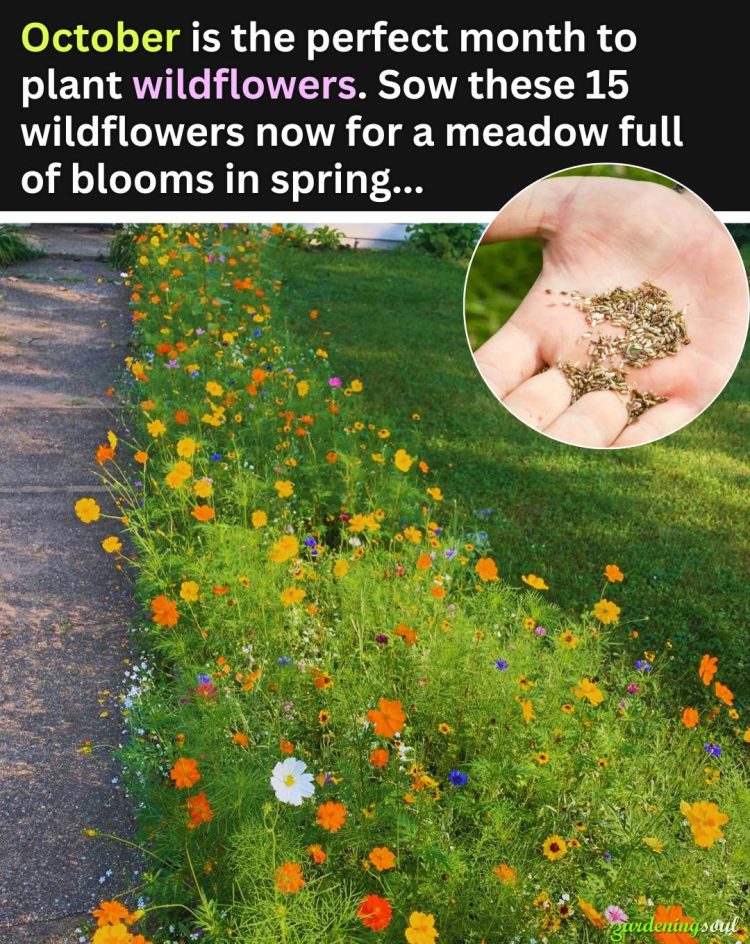When you picture a spring meadow bursting with vibrant colors, buzzing with bees, and dancing in the breeze, it may surprise you to learn that the secret to that beauty begins in the fall.
October is one of the best times to plant wildflowers, especially in temperate regions, because the soil is still warm enough to encourage seed germination, while cooler air temperatures prevent seedlings from drying out.
Fall sowing mimics what happens in nature: wildflowers drop their seeds at the end of summer, and those seeds rest through winter until spring conditions trigger growth.
By planting in October, you’re setting the stage for strong roots to develop before winter dormancy, ensuring your meadow wakes up full of life when spring arrives.
Why Plant Wildflowers in October?
Mimics Natural Cycles
Most wildflowers evolved to drop seeds in late summer or fall. These seeds go through a period of cold stratification during winter, which breaks dormancy and ensures strong germination in spring.
Better Root Establishment
By sowing in October, wildflowers have a chance to send down roots before the ground freezes. This means healthier plants with a head start when spring arrives.
Moisture Advantage
Fall and winter rains naturally water your seeds, reducing the need for supplemental irrigation.
Less Competition
Weeds are less aggressive in fall, giving wildflower seedlings an edge.
Earlier Blooms
Wildflowers sown in fall often bloom weeks earlier than those planted in spring.
Preparing Your Wildflower Meadow Site
Before jumping into the list of flowers, it’s important to prepare the ground properly:
Choose the right location: Most wildflowers prefer full sun (6+ hours daily), though some tolerate partial shade.
Clear weeds and grass: Remove existing vegetation to reduce competition. You can smother with cardboard, solarize with plastic, or till lightly.
Loosen the soil: Use a rake or garden fork to create a fine, crumbly seedbed. Avoid heavy tilling that brings up weed seeds.
Amend if needed: Wildflowers don’t need rich soil, but very poor or compacted soils may benefit from compost or sand for drainage.
Sow shallowly: Wildflower seeds need light to germinate. Scatter seeds evenly, press them gently into the soil with a roller or board, but don’t bury deeply.
15 Best Wildflowers to Plant in October
Each of the following wildflowers thrives when planted in fall and will reward you with a spectacular show in spring and beyond.
1. California Poppy (Eschscholzia californica)
Why Plant It: A symbol of resilience, the California poppy thrives in poor, sandy soils and brings meadows alive with bright orange, yellow, or red blooms.
Bloom Time: Spring to early summer.
Height: 12–18 inches.
Wildlife Value: Attracts bees, hoverflies, and butterflies.
Zones: 6–10 (perennial); annual in colder zones.
Companions: Lupine, coreopsis, cosmos.
Growing Tips:
Prefers full sun and well-draining soil.
Scatter seeds directly; they dislike transplanting.
Minimal water needed once established.
2. Cornflower (Centaurea cyanus)
Why Plant It: Also called bachelor’s button, cornflower is famous for its striking blue petals, though varieties also come in pink, purple, and white.
Bloom Time: Late spring to midsummer.
Height: 12–36 inches.
Wildlife Value: Beloved by bees, especially bumblebees.
Zones: 2–11 (annual).
Companions: Red poppies, daisies, nigella.
Growing Tips:
see continuation on next page
